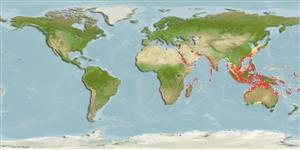Classification / Names
Common names | Synonyms | Catalog of Fishes (gen., sp.) | ITIS | CoL | WoRMS | Cloffa
Environment / Climate / Range
Ecology
Marine; brackish; reef-associated; depth range 1 - 97 m (Ref. 2142), usually 1 - 35 m (Ref. 90102). Tropical, preferred ?
Indo-West Pacific: Red Sea and Persian Gulf, Gulf of Oman and scattered localities in East Africa, Seychelles, India, Sri Lanka, the Indo-Malayan region, and Hong Kong; south to Australia; east to Fiji.
Size / Weight / Age
Maturity: Lm ? range ? - ? cm
Max length : 12.5 cm SL male/unsexed; (Ref. 31116)
Dorsal
spines
(total): 8;
Dorsal
soft rays
(total): 9;
Anal
spines: 2;
Anal
soft rays: 8;
Vertebrae: 24. Color in life coppery with iridescence; juveniles with peduncular spot, expanding to a broad blackish bar in adults; broad blackish stripe from front of snout to orbit, continuing diffusely behind eye; maxilla with a narrow blue streak. Preopercular ridge smooth, posterior and most of ventral margins serrate. Median predorsal scales 5.
Common in shallow coastal reefs with moderate currents (Ref. 48636). Also in tidal channels of estuaries (Ref. 48636). Adults usually in small schools comprising pairs (Ref. 48636).
Life cycle and mating behavior
Maturity | Reproduction | Spawning | Eggs | Fecundity | Larvae
Mouthbrooders (Ref. 240). Distinct pairing during courtship and spawning (Ref. 205).
Randall, J.E., T.H. Fraser and E.A. Lachner, 1990. On the validity of the Indo-Pacific cardinalfishes Apogon aureus (Lacepède) and A. fleurieu (Lacepède), with description of a related new species from the Red Sea. Proc. Biol. Soc. Wash. 103(1):39-62. (Ref. 2142)
IUCN Red List Status (Ref. 115185)
CITES (Ref. 94142)
Not Evaluated
Threat to humans
Harmless
Human uses
Fisheries: of no interest
More information
ReferencesAquacultureAquaculture profileStrainsGeneticsAllele frequenciesHeritabilityDiseasesProcessingMass conversion
Tools
Special reports
Download XML
Internet sources
Estimates of some properties based on models
Phylogenetic diversity index (Ref.
82805): PD
50 = 0.5000 [Uniqueness, from 0.5 = low to 2.0 = high].
Bayesian length-weight: a=0.01318 (0.00559 - 0.03107), b=3.09 (2.91 - 3.27), in cm Total Length, based on LWR estimates for this Genus-body shape (Ref.
93245).
Trophic Level (Ref.
69278): 3.6 ±0.5 se; Based on size and trophs of closest relatives
Resilience (Ref.
69278): High, minimum population doubling time less than 15 months (Preliminary K or Fecundity.).
Vulnerability (Ref.
59153): Low vulnerability (16 of 100) .
